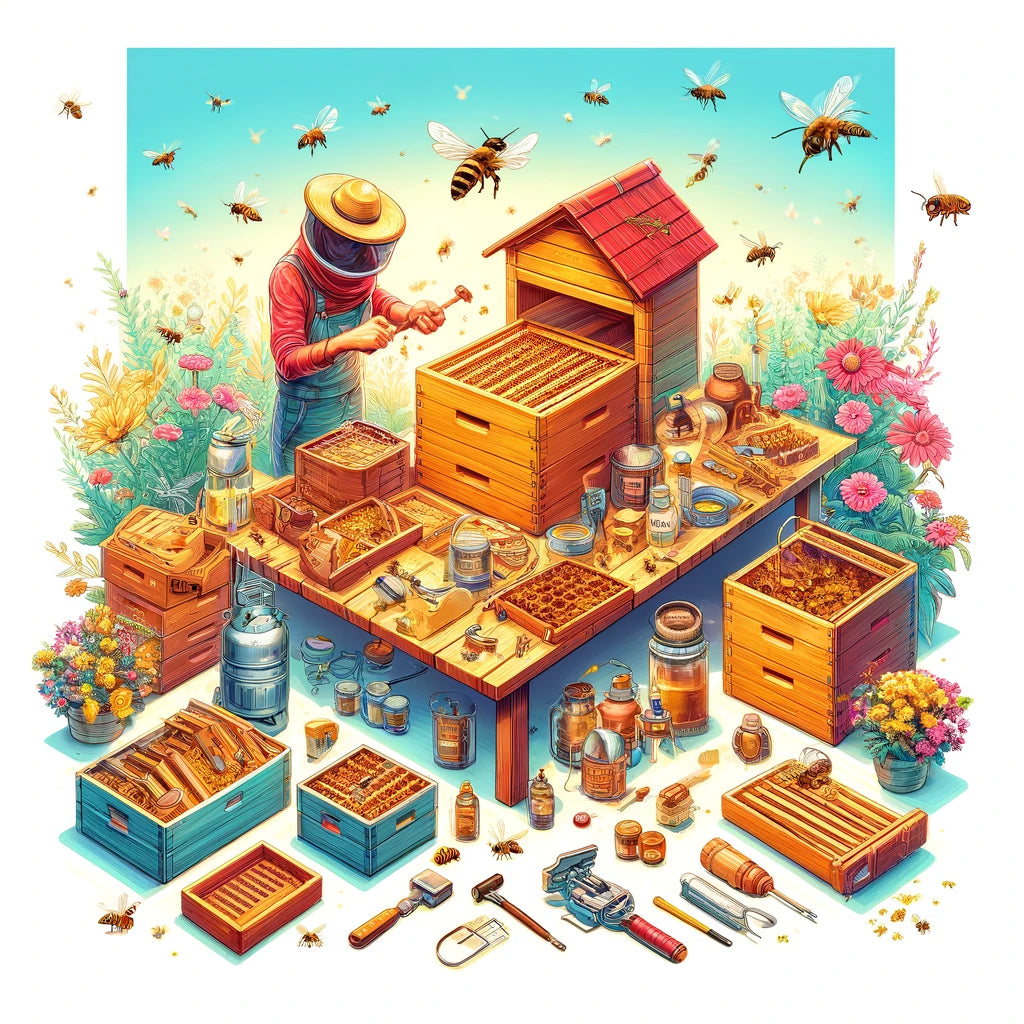
Beehive Components Part I: Building a Hive from Scratch
Building a beehive from scratch is essential for novice and experienced beekeepers, offering insights into the architecture supporting honeybee society. A beehive's design accommodates the bees' natural behaviors and facilitates beekeeping activities, including inspection, honey extraction, and maintenance.
Understanding the components of a bee hive is fundamental to successful beekeeping, enabling the customization of hives to meet specific needs and environments.
1. Hive Stand
Your beekeeping journey begins with the hive stand, the foundation that sets the stage for a healthy colony. Elevating your hive off the damp ground, the stand ensures better air circulation and reduces threats from pests.
Whether you opt for a simple wooden stand or a more durable stainless steel option, the key is maintaining dryness and insulation. Think of the hive stand as your colony's first line of defense, a critical yet often overlooked component that can significantly impact the health and productivity of your bees.
2. Bottom Board
The bottom board serves as the floor of your beehive and the main entrance for your bees. This pivotal component can be adjusted to control the hive's ventilation and security. During summer, a wider entrance allows for increased airflow and easier access, while a reduced entrance in winter helps maintain warmth and protect against invaders.
Consider a screened bottom board for enhanced ventilation and mite control, offering a dual benefit that supports bee health year-round.
3. Hive Body (Brood Chamber)
The hive body is where the magic happens: the queen lays her eggs here, and young bees grow. This box holds frames where bees store pollen and honey, which are essential for feeding the colony. Depending on your climate and colony size, you might stack two hive bodies, providing ample space for brood rearing and food storage. This setup is particularly beneficial in cooler regions, where larger food reserves are necessary for winter survival.
4. Queen Excluder
Positioning a queen excluder between the brood chamber and honey supers ensures that honey production is separate from brood rearing. This mesh barrier allows worker bees through but keeps the queen in the brood chamber, preventing her from laying eggs in the honey storage area. While not always necessary, especially in larger hives, it's handy for maintaining pure honey supers and simplifying your harvest.
5. Honey Supers
Above the brood chamber, you'll add honey supers, where bees store the excess honey. Designed to be lighter for ease of management during harvest, these supers come in various sizes to suit your handling preferences. Strategically adding honey supers as the colony grows and honey production increases is essential, ensuring your bees have enough space to store their golden treasure without feeling overcrowded.
6. Inner Cover
The inner cover is more than just a separator between the bees and the outer lid; it regulates the hive's internal environment. Providing insulation and proper airflow, the inner cover also prevents the bees from gluing the outer cover to the hive body, making your inspections and honey harvests hassle-free. Selecting the right inner cover design can significantly impact your hive's health and productivity.
7. Telescoping Cover
Your beehive's final layer of protection, the telescoping cover, shields your bees from harsh weather conditions. Extending over the hive's sides, this cover ensures rain and snow slide off without entering the hive. A durable, galvanized metal top can further protect against the elements, prolonging the life of your hive and offering your bees the comfort and security they need to thrive.
Frequently Asked Questions About BeeHive Components
Q: Can I use any wood for my hive stand and bodies?
A: While various kinds of wood can be used, durable and rot-resistant options like cedar or treated pine are recommended for longevity. Avoid toxic chemicals that could harm your bees.
Q: How often should I replace my queen excluder?
A: Inspect your queen excluder annually for damage or wear. Replacement is typically necessary only when it becomes bent, or the gaps widen, allowing the queen to pass through.
Q: Do I need to paint my honey supers?
A: Painting the exterior of honey supers can protect them from the elements, extending their lifespan. Use a non-toxic, exterior-grade paint and avoid painting the insides where bees store honey.
Q: Can I start with one hive body and add another later?
A: Yes, starting with one hive body and adding another as your colony grows is a common practice. This allows you to manage resources efficiently and expand your hive in response to the colony's needs.



Leave a comment